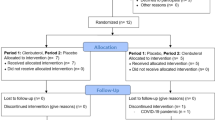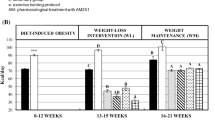Abstract
Background:
The sympathetic nervous system regulates energy metabolism via β-adrenoreceptors. Therapeutic exploitation of previous β2-adrenegic agonists for metabolic benefits has been hindered by cross stimulation of cardiac β1-adrenoceptor, causing tachycardia. Formoterol is a novel highly β2-selective adrenergic agonist and holds promise as a β2-agonist that could impart selective beneficial metabolic effects.
Objective:
To investigate the metabolic effects of formoterol on energy and substrate metabolism.
Participants:
Healthy volunteers.
Design:
(1) Dose-finding study, step-wise incremental design of weekly administration of 80, 160 and 320 μg daily of formoterol in four subjects and, (2) metabolic study, an open-label metabolic evaluation of 1-week treatment in eight men using a dose determined from (1).
Main outcome:
Resting energy expenditure (EE), diet-induced thermogenesis (DIT) and fat oxidation (Fox) using indirect calorimetry, heart rate and plasma non-esterified fatty acid (NEFA) levels.
Results:
In the dose-finding study, all three doses increased resting EE and Fox with the 320 μg dose significantly increasing heart rate. In the metabolic study, the selected 160 μg daily dose increased resting EE by 13±2% (P<0.001) and Fox by 23±4% (P<0.01), but not DIT. Plasma NEFA levels rose by 16±2% (P<0.01). Heart rate did not change significantly. Out of the eight subjects, six reported tremor and palpitation, two lost appetite and one suffered from insomnia.
Conclusions:
At a dose of 160 μg per day, formoterol increases resting EE and fat utilization without inducing tachycardia. From this first metabolic evaluation in humans, we conclude that formoterol imparts beneficial metabolic changes that may be exploited for therapy of obesity.
This is a preview of subscription content, access via your institution
Access options
Subscribe to this journal
Receive 12 print issues and online access
$259.00 per year
only $21.58 per issue
Buy this article
- Purchase on Springer Link
- Instant access to full article PDF
Prices may be subject to local taxes which are calculated during checkout



Similar content being viewed by others
References
Bray GA, Inoue S, Nishizawa Y . Hypothalamic obesity. The autonomic hypothesis and the lateral hypothalamus. Diabetologia 1981; 20 (Suppl): 366–377.
Bachman ES, Dhillon H, Zhang CY, Cinti S, Bianco AC, Kobilka BK et al. betaAR signaling required for diet-induced thermogenesis and obesity resistance. Science 2002; 297: 843–845.
Lee P, Zhao JT, Swarbrick MM, Gracie G, Bova R, Greenfield JR et al. High prevalence of brown adipose tissue in adult humans. J Clin Endocrinol Metab 2011; 96: 2450–2455.
Bjorgell P, Belfrage P . Characteristics of the lipolytic beta-adrenergic receptors in hamster adipocytes. Biochem Biophys Acta 1982; 713: 80–85.
Mersmann HJ . Acute metabolic effects of adrenergic agents in swine. Am J Physiol 1987; 252 (1 Part 1): E85–E95.
Lee P, Kengne AP, Greenfield JR, Day RO, Chalmers J, Ho KK . Metabolic sequelae of beta-blocker therapy: weighing in on the obesity epidemic? Int J Obes 2011; 35: 1395–1403.
Schiffelers SL, Saris WH, Boomsma F, van Baak MA . beta(1)- and beta(2)-Adrenoceptor-mediated thermogenesis and lipid utilization in obese and lean men. J Clin Endocrinol Metab 2001; 86: 2191–2199.
Lofdahl CG, Svedmyr N . Formoterol fumarate, a new beta 2-adrenoceptor agonist. Acute studies of selectivity and duration of effect after inhaled and oral administration. Allergy 1989; 44: 264–271.
Trazzi S, Mutti E, Frattola A, Imholz B, Parati G, Mancia G . Reproducibility of non-invasive and intra-arterial blood pressure monitoring: implications for studies on antihypertensive treatment. J Hypertens 1991; 9: 115–119.
Burt MG, Gibney J, Ho KK . Characterization of the metabolic phenotypes of Cushing's syndrome and growth hormone deficiency: a study of body composition and energy metabolism. Clin Endocrinol 2006; 64: 436–443.
Ferrannini E . The theoretical bases of indirect calorimetry: a review. Metabolism 1988; 37: 287–301.
O'Sullivan AJ, Kelly JJ, Hoffman DM, Freund J, Ho KK . Body composition and energy expenditure in acromegaly. J Clin Endocrinol Metab 1994; 78: 381–386.
Astrup A . The sympathetic nervous system as a target for intervention in obesity. Int J Obes Relat Metab Disord 1995; 19 (Suppl 7): S24–S28.
Hoeks J, van Baak MA, Hesselink MK, Hul GB, Vidal H, Saris WH et al. Effect of beta1- and beta2-adrenergic stimulation on energy expenditure, substrate oxidation, and UCP3 expression in humans. Am J Physiol Endocrinol Metab 2003; 285 (4): E775–E782.
Blaak EE, Schiffelers SL, Saris WH, Mensink M, Kooi ME . Impaired beta-adrenergically mediated lipolysis in skeletal muscle of obese subjects. Diabetologia 2004; 47: 1462–1468.
Jocken JW, Roepstorff C, Goossens GH, van der Baan P, van Baak M, Saris WH et al. Hormone-sensitive lipase serine phosphorylation and glycerol exchange across skeletal muscle in lean and obese subjects: effect of beta-adrenergic stimulation. Diabetes 2008; 57: 1834–1841.
Jocken JW, Blaak EE, van der Kallen CJ, van Baak MA, Saris WH . Blunted beta-adrenoceptor-mediated fat oxidation in overweight subjects: a role for the hormone-sensitive lipase gene. Metabolism 2008; 57: 326–332.
Jocken JW, Blaak EE, Schiffelers S, Arner P, van Baak MA, Saris WH . Association of a beta-2 adrenoceptor (ADRB2) gene variant with a blunted in vivo lipolysis and fat oxidation. Int J Obes 2007; 31: 813–819.
Blaak EE, van Baak MA, Saris WH . Beta-adrenergically stimulated fat oxidation is diminished in middle-aged compared to young subjects. J Clin Endocrinol Metab 1999; 84: 3764–3769.
Blaak EE, Kemerink GJ, Pakbiers MT, Wolffenbuttel BH, Heidendal GA, Saris WH . Microdialysis assessment of local adipose tissue lipolysis during beta-adrenergic stimulation in upper-body-obese subjects with type II diabetes. Clin Sci 1999; 97: 421–428.
Blaak EE, Saris WH, Wolffenbuttel BH . Substrate utilization and thermogenic responses to beta-adrenergic stimulation in obese subjects with NIDDM. Int J Obes Relat Metab Disord 1999; 23: 411–418.
Kraenzlin ME, Keller U, Keller A, Thelin A, Arnaud MJ, Stauffacher W . Elevation of plasma epinephrine concentrations inhibits proteolysis and leucine oxidation in man via beta-adrenergic mechanisms. J Clin Invest 1989; 84: 388–393.
White WB . Heart rate and the rate-pressure product as determinants of cardiovascular risk in patients with hypertension. Am J Hypertens 1999; 12 (2 Part 2): 50S–55S.
Ryall JG, Schertzer JD, Lynch GS . Attenuation of age-related muscle wasting and weakness in rats after formoterol treatment: therapeutic implications for sarcopenia. J Gerontol A Biol Sci Med Sci 2007; 62: 813–823.
Philipson LH . beta-Agonists and metabolism. J Allergy Clin Immunol 2002; 110 (6 Suppl): S313–S317.
Guhan AR, Cooper S, Oborne J, Lewis S, Bennett J, Tattersfield AE . Systemic effects of formoterol and salmeterol: a dose-response comparison in healthy subjects. Thorax 2000; 55 (8): 650–656.
Brodde OE, Daul A, Michel MC . Subtype-selective modulation of human beta 1- and beta 2-adrenoceptor function by beta-adrenoceptor agonists and antagonists. Clin Physiol Biochem 1990; 8 (Suppl 2): 11–17.
Lynch GS, Ryall JG . Role of beta-adrenoceptor signaling in skeletal muscle: implications for muscle wasting and disease. Physiol Rev 2008; 88 (2): 729–767.
van Marken Lichtenbelt WD, Vanhommerig JW, Smulders NM, Drossaerts JM, Kemerink GJ, Bouvy ND et al. Cold-activated brown adipose tissue in healthy men. N Engl J Med 2009; 360 (15): 1500–1508.
Author information
Authors and Affiliations
Corresponding author
Ethics declarations
Competing interests
Dr Paul Lee was funded by an Australian National Health Medical Research Council postgraduate scholarship. The other authors declare no conflict of interest.
Rights and permissions
About this article
Cite this article
Lee, P., Day, R., Greenfield, J. et al. Formoterol, a highly β2-selective agonist, increases energy expenditure and fat utilisation in men. Int J Obes 37, 593–597 (2013). https://doi.org/10.1038/ijo.2012.90
Received:
Revised:
Accepted:
Published:
Issue Date:
DOI: https://doi.org/10.1038/ijo.2012.90
Keywords
This article is cited by
-
The involvement of the adrenergic nervous system in activating human brown adipose tissue and browning
Hormones (2022)
-
Beta2-adrenergic stimulation increases energy expenditure at rest, but not during submaximal exercise in active overweight men
European Journal of Applied Physiology (2017)
-
Beta2-Agonist Doping Control and Optical Isomer Challenges
Sports Medicine (2016)



